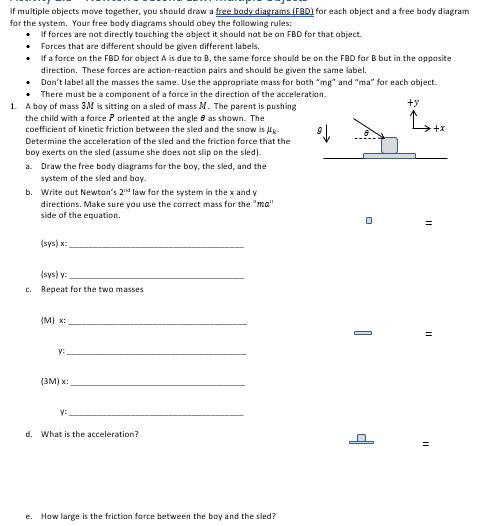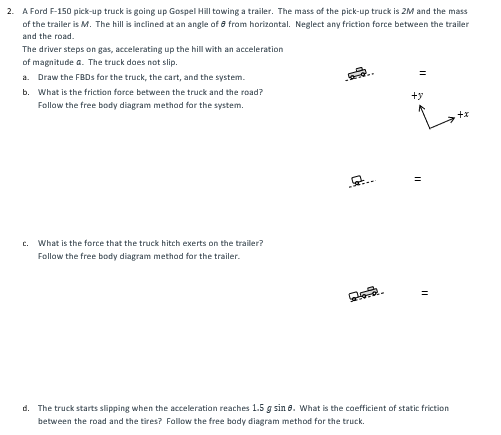If multiple objects move together, you should draw a free body diagrams (FBD) for each object and a free body diagram for the system. Your free body diagrams should obey the following rules: • If forces are not directly touching the object it should not be an FBD for that object. Forces that are different should be given different labels. • If a force on the FBD for object A is due to B, the same force should be on the FBD for B but in the opposite direction. These forces are action-reaction pairs and should be given the same label. Don't label all the masses the same. Use the appropriate mass for both "mg" and "ma" for each object. There must be a component of a force in the direction of the acceleration. 1. A boy of mass 3M is sitting on a sled of mass M. The parent is pushing +y the child with a force P oriented at the angle as shown. The coefficient of kinetic friction between the sled and the snow is μg- Determine the acceleration of the sled and the friction force that the boy exerts on the sled (assume she does not slip on the sled). a. Draw the free body diagrams for the boy, the sled, and the system of the sled and boy. b. Write out Newton's 2nd law for the system in the x and y directions. Make sure you use the correct mass for the "ma" side of the equation. ↓ 0 11 +x
If multiple objects move together, you should draw a free body diagrams (FBD) for each object and a free body diagram for the system. Your free body diagrams should obey the following rules: • If forces are not directly touching the object it should not be an FBD for that object. Forces that are different should be given different labels. • If a force on the FBD for object A is due to B, the same force should be on the FBD for B but in the opposite direction. These forces are action-reaction pairs and should be given the same label. Don't label all the masses the same. Use the appropriate mass for both "mg" and "ma" for each object. There must be a component of a force in the direction of the acceleration. 1. A boy of mass 3M is sitting on a sled of mass M. The parent is pushing +y the child with a force P oriented at the angle as shown. The coefficient of kinetic friction between the sled and the snow is μg- Determine the acceleration of the sled and the friction force that the boy exerts on the sled (assume she does not slip on the sled). a. Draw the free body diagrams for the boy, the sled, and the system of the sled and boy. b. Write out Newton's 2nd law for the system in the x and y directions. Make sure you use the correct mass for the "ma" side of the equation. ↓ 0 11 +x
Glencoe Physics: Principles and Problems, Student Edition
1st Edition
ISBN:9780078807213
Author:Paul W. Zitzewitz
Publisher:Paul W. Zitzewitz
Chapter5: Displacement And Force In Two Dimensions
Section: Chapter Questions
Problem 104A
Related questions
Topic Video
Question
d,e and No2

Transcribed Image Text:If multiple objects move together, you should draw a free body diagrams (FBD) for each object and a free body diagram
for the system. Your free body diagrams should obey the following rules:
• If forces are not directly touching the object it should not be on FBD for that object.
•
Forces that are different should be given different labels.
•
If a force on the FBD for object A is due to B, the same force should be on the FBD for B but in the opposite
direction. These forces are action-reaction pairs and should be given the same label.
•
Don't label all the masses the same. Use the appropriate mass for both "mg" and "ma" for each object.
There must be a component of a force in the direction of the acceleration.
1. A boy of mass 3M is sitting on a sled of mass M. The parent is pushing
•
the child with a force P oriented at the angle as shown. The
coefficient of kinetic friction between the sled and the snow is g-
Determine the acceleration of the sled and the friction force that the
boy exerts on the sled (assume she does not slip on the sled).
a. Draw the free body diagrams for the boy, the sled, and the
system of the sled and boy.
b. Write out Newton's 2nd law for the system in the x and y
directions. Make sure you use the correct mass for the "ma"
side of the equation.
(sys) x:
(sys) y:
c. Repeat for the two masses
(M) x:
y:
(3M) x:
y:
d. What is the acceleration?
e. How large is the friction force between the boy and the sled?
2↓
I
ty
=
11
11

Transcribed Image Text:2. A Ford F-150 pick-up truck is going up Gospel Hill towing a trailer. The mass of the pick-up truck is 2M and the mass
of the trailer is M. The hill is inclined at an angle of 6 from horizontal. Neglect any friction force between the trailer
and the road.
The driver steps on gas, accelerating up the hill with an acceleration
of magnitude a. The truck does not slip.
a. Draw the FBDs for the truck, the cart, and the system.
b. What is the friction force between the truck and the road?
Follow the free body diagram method for the system.
C. What is the force that the truck hitch exerts on the trailer?
Follow the free body diagram method for the trailer.
+y
d. The truck starts slipping when the acceleration reaches 1.5 g sin 8. What is the coefficient of static friction
between the road and the tires? Follow the free body diagram method for the truck.
+*
Expert Solution
This question has been solved!
Explore an expertly crafted, step-by-step solution for a thorough understanding of key concepts.
Step by step
Solved in 4 steps with 5 images

Knowledge Booster
Learn more about
Need a deep-dive on the concept behind this application? Look no further. Learn more about this topic, physics and related others by exploring similar questions and additional content below.Recommended textbooks for you

Glencoe Physics: Principles and Problems, Student…
Physics
ISBN:
9780078807213
Author:
Paul W. Zitzewitz
Publisher:
Glencoe/McGraw-Hill

University Physics Volume 1
Physics
ISBN:
9781938168277
Author:
William Moebs, Samuel J. Ling, Jeff Sanny
Publisher:
OpenStax - Rice University

Glencoe Physics: Principles and Problems, Student…
Physics
ISBN:
9780078807213
Author:
Paul W. Zitzewitz
Publisher:
Glencoe/McGraw-Hill

University Physics Volume 1
Physics
ISBN:
9781938168277
Author:
William Moebs, Samuel J. Ling, Jeff Sanny
Publisher:
OpenStax - Rice University